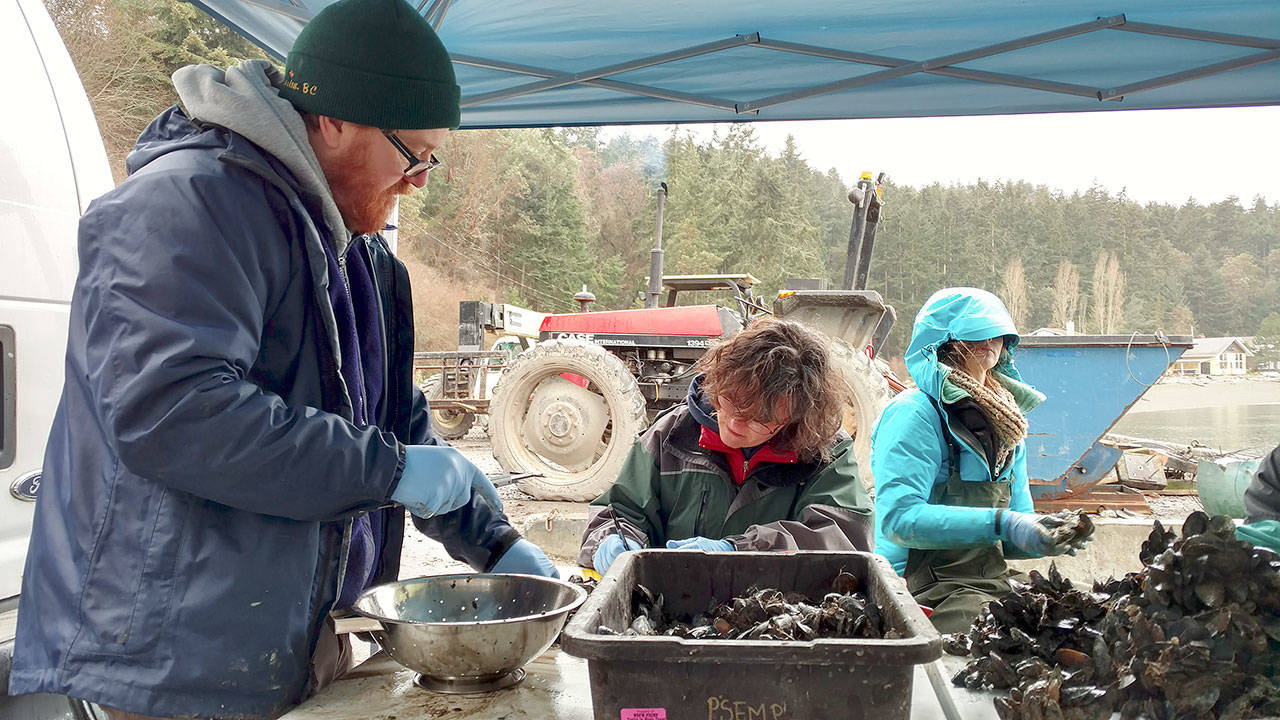Coupeville served up tons of Penn Cove mussels during this month’s MusselFest. Now the tiny briny blue bivalves will serve science throughout Puget Sound by acting as miniature environmental detectives.
Last month, a state toxicology team led local volunteers in collecting, sorting, and measuring mussels for a program designed to detect copper in marine waters.
A new state law going into effect Jan. 1, 2018, bans copper-containing paint on new recreational boats. Copper has long been used in paint for the hulls of boats to prevent algae and other marine growth.
“Generally, copper is more acutely toxic in dissolved form to lower organisms, such as algae, which is why it is used as an algaecide in paints,” explained William Hobbs of Washington State Department of Ecology Environmental Assessment Program. “There can also be impacts to embryonic stages of mussels.”
Salmon are likely exposed to copper through diet and long-term exposure through their gills, potentially affecting their sense of smell, which is vital in spawning.
Clean mussels donated by Coupeville’s Penn Cove Shellfish will end up in five marinas around Puget Sound, explained Jennifer Lanksbury with the Washington Department of Fish and Wildlife.
“The mussels will be left out for about three months and then their tissues will be analyzed for a range of metals, including copper,” she said.
After the law has been in effect for a few years, the mussels could serve as the “before” data in comparison with a new “after” batch placed in the same marinas.
Washington is the first state to pass such legislation. A lawsuit filed several years ago by Puget Soundkeeper Alliance sued five boatyards under the Clean Water Act about the copper problem. This prompted the Northwest Marine Trade Association to sponsor legislation to phase out copper paint entirely.
Under the law, no new boats with copper-based bottom paint can be sold in Washington state after Jan. 1, 2018, and no paint with more than 0.5 percent copper can be used on recreation boats as of 2020. The law applies only to recreational boats 65 feet and under.
Friday Harbor, Skyline Marina (Anacortes), John Wayne Marina (Sequim Bay), Des Moines Marina, and Swantown Marina, Olympia, are the sites chosen for the study.
“Marinas were chosen so as to make sure we had different sizes and configurations, not because we thought these would have poor water quality,” Hobbs said. “Each marina has a local reference site for comparison of copper concentrations. Additional samples for water and suspended sediment are also being collected.”
During the last two chilly days of February, Lanksbury led a team of Sound Water Steward volunteers on the shores of Penn Cove.
Under steel gray skies and whipsaw wind, muddy mussels were washed, measured, bagged and tagged by the group of “citizen scientists” that receive 100 hours of training about shore marine environments, marine biology, watersheds and groundwater, oceanography, salmon and near shore habitats, climate change and other topics.
Sound Water Stewards started in 1989 as a program of Washington State University Extension, called Island County Beach Watchers. In January 2016, it changed names and became its own independent non-profit organization led by a board of directors.
Jim Somers started volunteering about a dozen years ago after moving to Whidbey Island from Duluth, Minn.
“I was interested in the marine environment and found their extensive training program to be the ideal vehicle for education leading to numerous environmental volunteer opportunities,” said Somers, a retired orthodontist.
The National Mussel Watch Program, managed by the National Oceanic and Atmospheric Administration for about 20 years, tracked changing levels of pollution at up to 20 different locations in Puget Sound, the Olympic Coast and the Straits of Georgia and Juan de Fuca.
Over the years, it discovered that parts of Puget Sound had significantly higher amounts of potentially cancer-causing pollutants called polycyclic aromatic hydrocarbons (PAHs) than anywhere else in the United States, including heavily trafficked ports like Los Angeles and San Francisco Bay, according to NOAA’s Office of Response and Restoration website.
When funding dwindled for the federal program, various state, county, tribal and local groups stepped in to continue the program; mussel sampling is now expanded to some 65 sites.
Volunteers — and donated Penn Cove mussels — are vital to the studies, observed Lanksbury, with Fish and Wildlife’s Toxics-focused Biological Observing System. (She stressed that mussels in Penn Cove are safe to eat.)
“For all the mussel monitoring we’ve done in Puget Sound we’ve relied heavily on volunteers,” she said. “Without the help of our volunteers we wouldn’t be able to conduct our monitoring on such a large scale – they are invaluable.”


